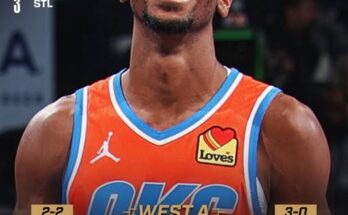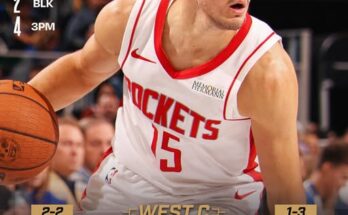Update: Jonathan Kuminga is leaning toward accepting the Golden State Warriors’ one-year, \$7.9 million qualifying offer rather than the team’s proposed two-year, \$45 million deal. Sources say nothing has changed in the past 10 days — the Warriors haven’t increased their offer, and Kuminga has reportedly told those close to him that the qualifying offer is currently more appealing. With the Oct. 1 deadline approaching, both sides face mounting pressure for a resolution.
Jonathan Kuminga’s contract situation with the Golden State Warriors has taken a surprising turn, and it’s quickly becoming one of the more intriguing storylines of the offseason for the franchise. According to multiple reports and sources close to the situation, Kuminga is leaning toward accepting the Warriors’ one-year qualifying offer worth \$7.9 million rather than agreeing to the team’s current multi-year proposal of two years at \$45 million. This decision, if it holds, could have significant implications not only for the Warriors’ roster construction in the short term but also for the future of Kuminga’s career and the franchise’s long-term planning.
Over the last 10 days, there has been no movement on either side. The Warriors have not sweetened their offer, and Kuminga has not softened his stance. In fact, those within his inner circle have been told directly by the young forward that the qualifying offer appeals to him more than the team’s current pitch. That statement alone speaks volumes, as it suggests that Kuminga may be ready to gamble on himself — taking less guaranteed money now in hopes of securing a much larger payday in the near future. With the October 1 deadline looming, the clock is ticking for both parties, and “something has to give” before time runs out.
The qualifying offer is essentially a one-year contract that would keep Kuminga with the Warriors for the 2025–26 season at a predetermined salary — in this case, \$7.9 million. After that season, Kuminga would become an unrestricted free agent, free to negotiate with any team without the Warriors having the right to match offers. By opting for the qualifying offer instead of signing the proposed two-year deal, Kuminga would be betting that his performance in the upcoming season would drive up his market value to a point where he could command a far larger, long-term contract in the summer of 2026.
From Kuminga’s perspective, there is logic in this approach. He’s 22 years old, still improving, and entering what could be a pivotal year in his development. Last season, Kuminga showed flashes of brilliance, particularly in the second half of the year when he earned more consistent minutes and an expanded role. His athleticism, defensive versatility, and ability to create his own shot have made him a tantalizing piece in the Warriors’ rotation, even if he hasn’t fully broken out yet. If he believes he can put together a strong, career-best season, he could hit free agency at the perfect time — when teams have more cap space and are eager to invest in young, ascending talent.
The risk, of course, is significant. Taking the qualifying offer means giving up the security of a guaranteed \$45 million over the next two years. If Kuminga struggles, suffers a major injury, or sees his role diminish, his free-agent market in 2026 could be far less lucrative than it is now. For most players, that guaranteed money provides peace of mind and financial stability. Walking away from it takes confidence, conviction, and a willingness to take on substantial risk.
From the Warriors’ perspective, the situation is equally complex. The franchise is in a transitional period, still anchored by the legendary core of Stephen Curry, Draymond Green, and Klay Thompson, but clearly aware that their championship window will not remain open forever. Kuminga has been seen as one of the bridge pieces to the next era — a young, athletic forward who could help the team stay competitive as the older stars age. The Warriors’ two-year, \$45 million offer appears designed to keep Kuminga in the fold during this transition, but it also allows the team some financial flexibility in the longer term.
By not increasing their offer, the Warriors may be signaling that they value Kuminga, but not at the level he might command if he were already a proven All-Star. They may also be hesitant to commit big money over a longer term until they’ve seen him consistently perform at a high level. This stalemate could be a calculated game of patience on their end — waiting to see if Kuminga blinks before the deadline.
However, if Kuminga does stick with the qualifying offer, the Warriors could face the uncomfortable reality of potentially losing him for nothing in free agency a year later. That risk might put pressure on the front office to either improve their offer before October 1 or explore trade possibilities to avoid that scenario.
Historically, players who choose the qualifying offer over a longer extension are rare. It’s a high-stakes move that typically happens when a player and a team are far apart in their valuation of the player’s worth, or when the player is confident enough to believe he can greatly increase his value in a short period of time. Some players who have taken this route have gone on to secure massive deals, while others have seen their gamble backfire. For Kuminga, whose career trajectory still feels like it’s on the rise, this decision could define the next decade of his basketball journey.
There’s also the matter of fit within the Warriors’ current roster and system. Kuminga’s growth has at times been slowed by the team’s reliance on veteran lineups and a motion-heavy offense that prioritizes spacing, ball movement, and shooting — skills that aren’t his strongest attributes. He thrives in transition, in isolation situations, and when attacking the rim aggressively. If head coach Steve Kerr and his staff commit to giving him more freedom and consistent minutes, Kuminga could produce the kind of numbers that validate his belief in himself. On the other hand, if his role remains limited, the decision to pass on guaranteed money could appear much riskier in hindsight.
The looming October 1 deadline adds tension to the situation. Until then, both sides can negotiate, explore compromises, and attempt to find common ground. Once the deadline passes, Kuminga’s path for the season will be locked in, whether that means playing on the qualifying offer or under a new contract. The Warriors have been in high-stakes negotiations before, but this case is unique because it involves a young player with star potential whose best years are still ahead of him.
For the Warriors’ fan base, the uncertainty around Kuminga’s future is a mix of excitement and anxiety. On one hand, his confidence and willingness to bet on himself are admirable traits that suggest a strong competitive drive. On the other hand, the possibility of losing him in free agency without adequate return would be a bitter pill for fans and the organization to swallow.
The next several weeks will likely be filled with speculation, rumors, and potential leaks as both sides try to shape the narrative. It wouldn’t be surprising to see other teams closely monitoring the situation, perhaps even positioning themselves to make an aggressive move for Kuminga in the future. His combination of youth, athleticism, and untapped potential makes him a valuable commodity across the league.
Ultimately, the choice in front of Kuminga boils down to security versus upside. The two-year, \$45 million deal offers the safety net of guaranteed earnings and the comfort of staying with a team that has invested in his development. The one-year, \$7.9 million qualifying offer, however, offers freedom and the possibility of a much bigger payday — but only if he delivers on the court.
If history is any guide, high-stakes contract standoffs like this often come down to the final days, if not the final hours, before the deadline. Until then, both Jonathan Kuminga and the Golden State Warriors will be weighing their options carefully, knowing that the decision made in the coming weeks could reshape not only the player’s career but also the team’s future direction. For now, the message from both camps is clear: nothing has changed, and the standoff remains exactly where it was 10 days ago. But with the clock ticking toward October 1, change is coming — one way or another.



